Red Star Belgrade is at the new beginning.
After a lucrative few years under Vladan Milojević, this winter, they underwent a staff change and appointed club and Serbian football legend Dejan Stanković as their new manager.
The switch in the managerial position expectedly brought with it some modifications in the style of play and usage of individuals, resulting in a complete change of approach after the month of their work together.
The biggest news for the Red and Whites is the promotion of youngsters into important first-team roles, starting with Željko Gavrić and Strahinja Eraković, who spent the first part of the season in their filial Grafičar in the Serbian Second division.
Also, the young players who were in the squad during the autumn got their minutes and responsibilities in Stanković’s system and now are the key players for his tactics to succeed.
Veljko Nikolić and Njegoš Petrović are the two players who made the biggest leap under the new coach. They got the chance to become regular starters and carry the team’s ideas as what seems like the main catalysts of Red Star’s new game.
The two 20-year-olds are compatible midfielders with two different skill sets.
They open up space for each other, which allows them to play together and elevate their side’s play to a whole new level.
If they continue their development in the same manner as they started from the beginning of the second part of the season, they will easily become key guys in Serbian football, and high-value targets for Europe’s top-flight teams.
This tactical analysis scout report will show you
Nikolić and Petrović’s roles in the new manager’s tactics, their biggest strengths that bring them the spotlight, and why they could be thehottest goods in future transfer windows.
High positioning and the “in-between” play
In the past three years, Serbian champions have achieved good results playing well-organised defensive football, with discipline as their number one idea. It was obvious that that would change after they switched managers.
After Stanković came, it was clear that they would focus more on possession-based football, trying to utilize the potential of their young midfielders, so Petrović and Nikolić got their chances to show what they got.
Marko Marin and Rajiv van la Para, Red Star’s highest-paid players, exited Rajko Mitić stadium, opening up the spots for fresh blood, who came in the form of the two midfielders.
They did a great job during the winter preparations and locked themselves in the starting lineup. Njegoš Petrović plays the box-to-box role, while Veljko Nikolić is the true embodiment of the “number ten” we used to love.
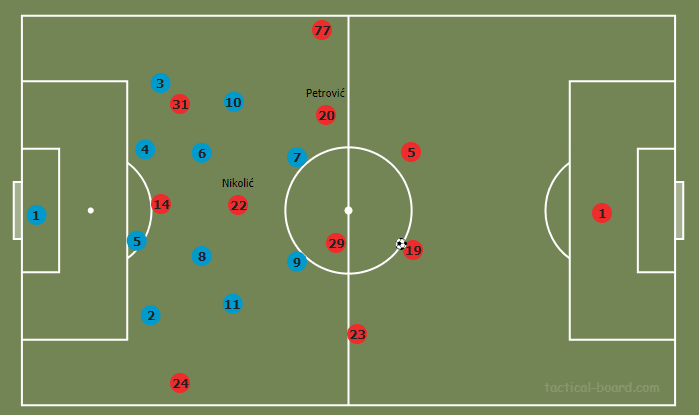
Here, we can see the standard initial setup of Red Star’s tactics with Petrović at the right defensive midfielder position and Nikolić starting higher and closer to his forwards.
Although that is the most commonly used opening idea, this formation undergoes many modifications throughout the match and usually looks a little bit different with both of the youngsters positioned higher in the half-spaces but with different tasks.
It is common for them to switch sides and don’t play that strictly in the left or right inner corridor.
Keeping everything in mind, Nikolić is always the one player who positions himself closer to the ball in the gaps on the overloaded side due to his positioning skills and good passing game.
Meanwhile, Petrović goes to the further half-space from where he provides an in-deep option or support to his teammate.
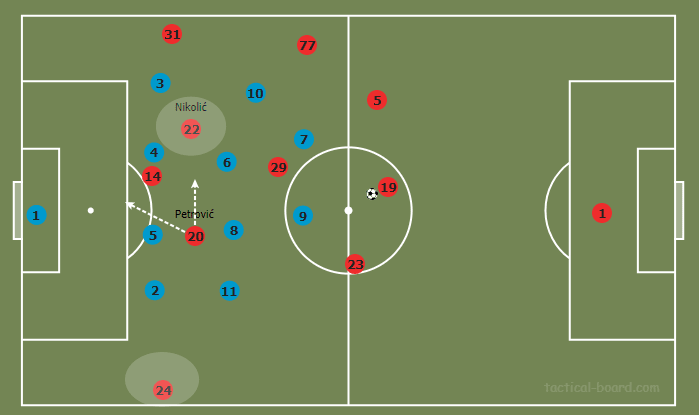
While the two of them are mostly close to the action, wingers play widely and wait for them to isolate them with passes from the midfielders.
The two young Serbs are good under pressure and often manage to find forward passes when they are in tough positions, which enables Red Star to play in the tight zones and thrive.
Nikolić and Petrović often “work for each other”, opening the passing lanes for one another by dragging the opposition’s attention to themselves.
Those setups frequently happen in the final third of the pitch, where highly positioned Njegoš commonly tries to occupy half-space to call defenders to guard him while his playmaker breaks open in the same position on the opposite side.
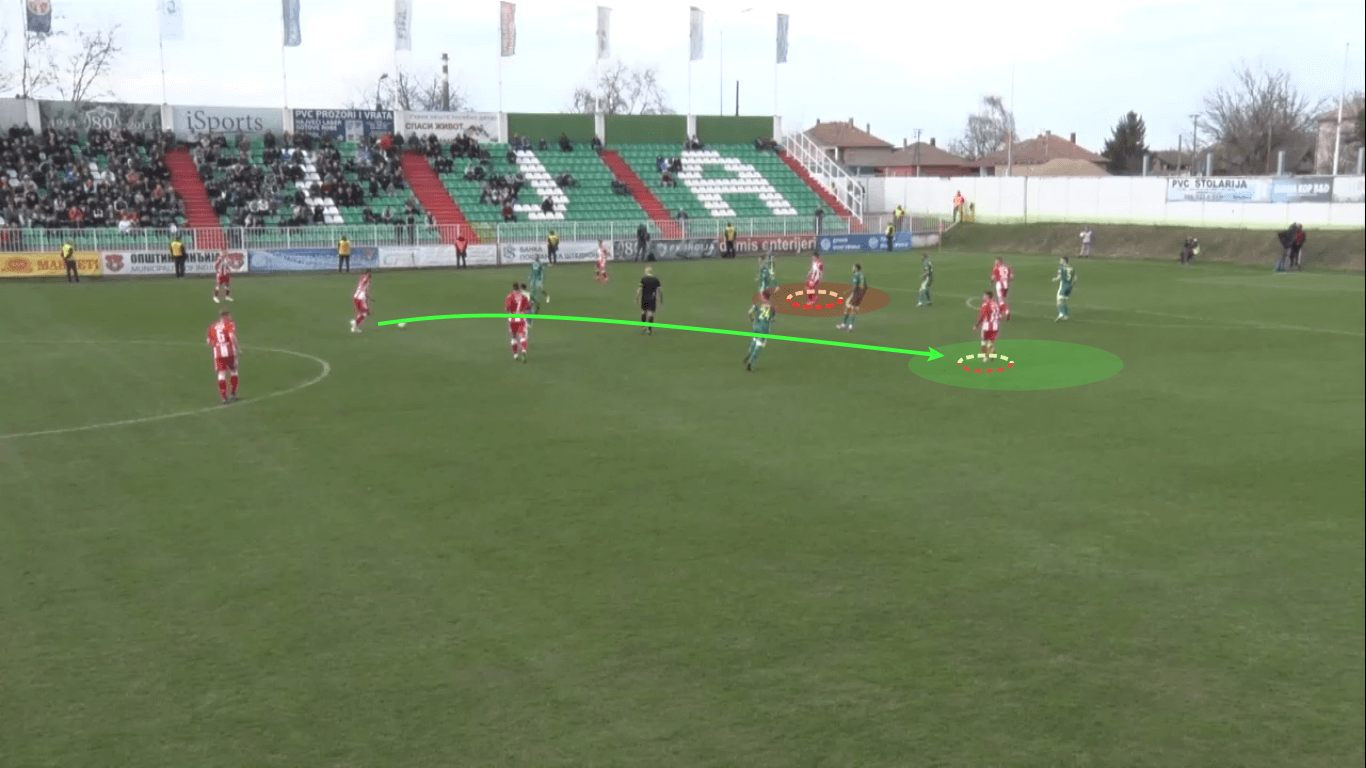
The picture above shows an example of their good cooperation in the high zones of the pitch.
They both tend to operate in the gaps between the lines, with Nikolić feeling more comfortable assisting from these areas and Petrović trying to run in and endanger the opponent’s goal.
That leads to the first of two playing mostly as a supportive player who brilliantly tracks down his team’s actions and provides his attackers with a nonstop passing option.
After that, he gets the keys of the play progress to himself.
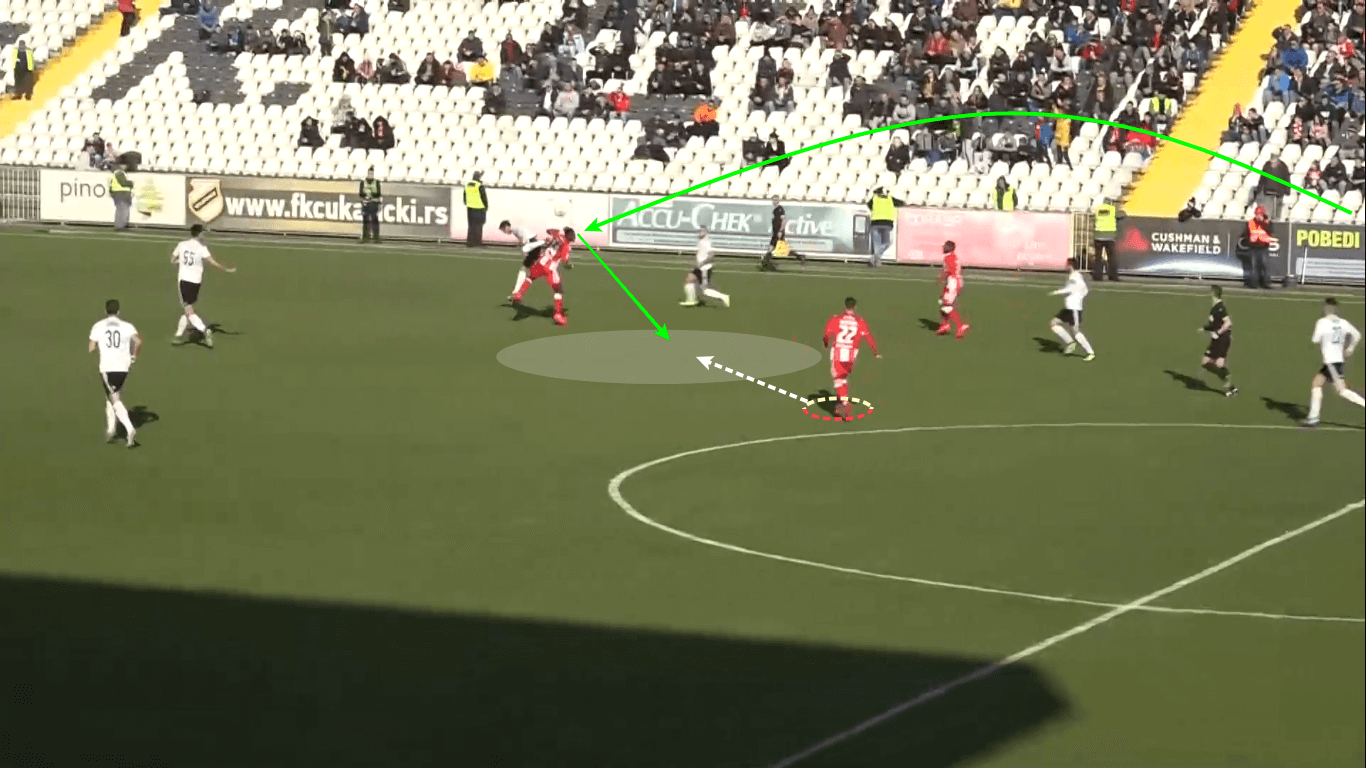
The number 22 senses the free space between the opposition’s lines and comes closer to the action so he can enable their attack to move forward.
He is also good at winning the second balls out of similar setups.
While he still needs to work on his physicality, he has good timing and doesn’t step up from the duel against tougher players.
As we mentioned a few times before, Petrović isn’t the player whose main strength is the passing game—although he is not bad in it—but his perfect sense of space and ability to overlap down the full length of half-spaces make him a great box-to-boxer.
He, on the other hand, has remarkable physical skills and has a long step that enables him to conquer the field both on and off the ball.
When positioned higher, he tends to go for the space between the full-back and centre-back, allowing his side an extra option in the closing stages of attacks.
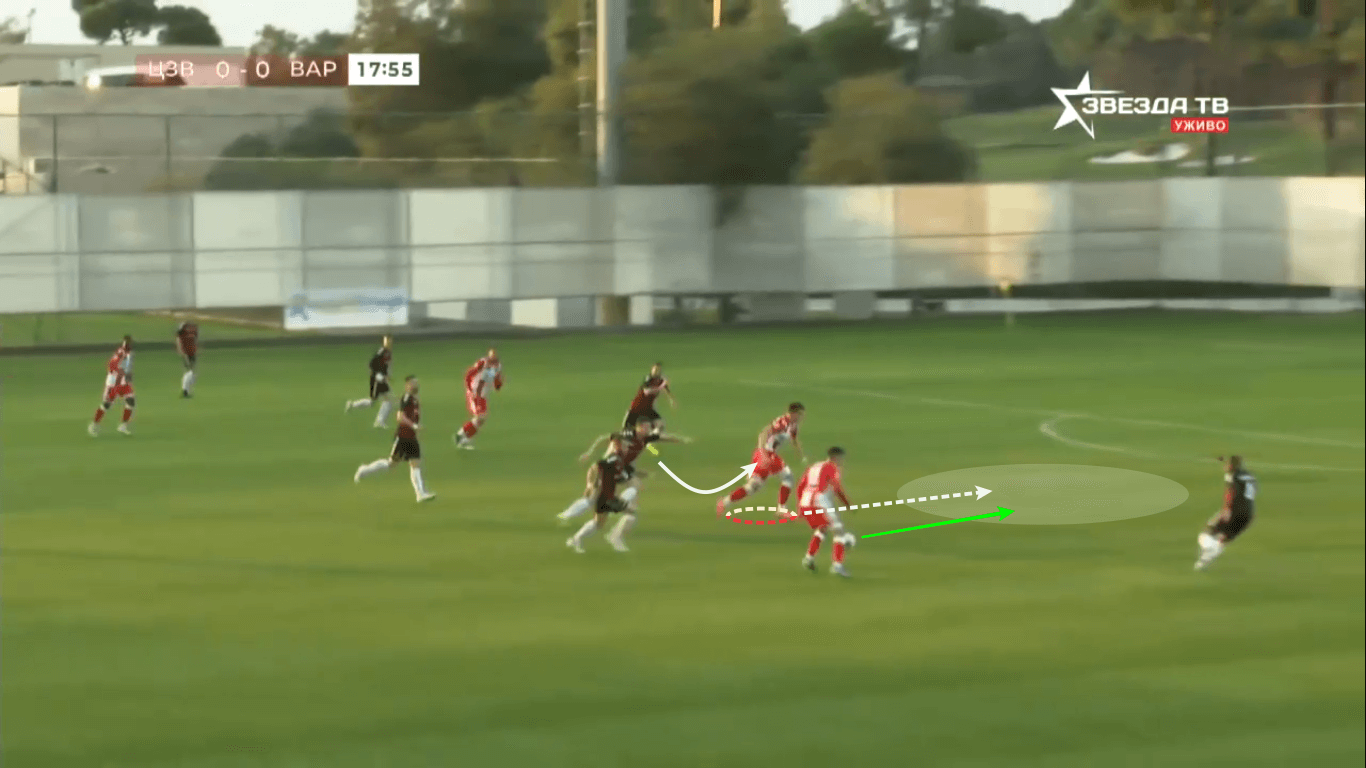
Petrović’s body orientation helps him gain an advantage in those situations.
He positions himself on the defender’s closer shoulder and does a fast turn, from which he goes directly in the empty space in full steam, leaving the direct guard behind him and going into the opportunity.
A similar thing happens when he is positioned even higher and waiting for the long ball from his defenders.
The midfielder tries to gain an initial advantage by opening up his body and sitting at the edge of an offside, timing his run perfectly and getting the in-deep balls in wider positions from where he mostly goes for the inwards pass.
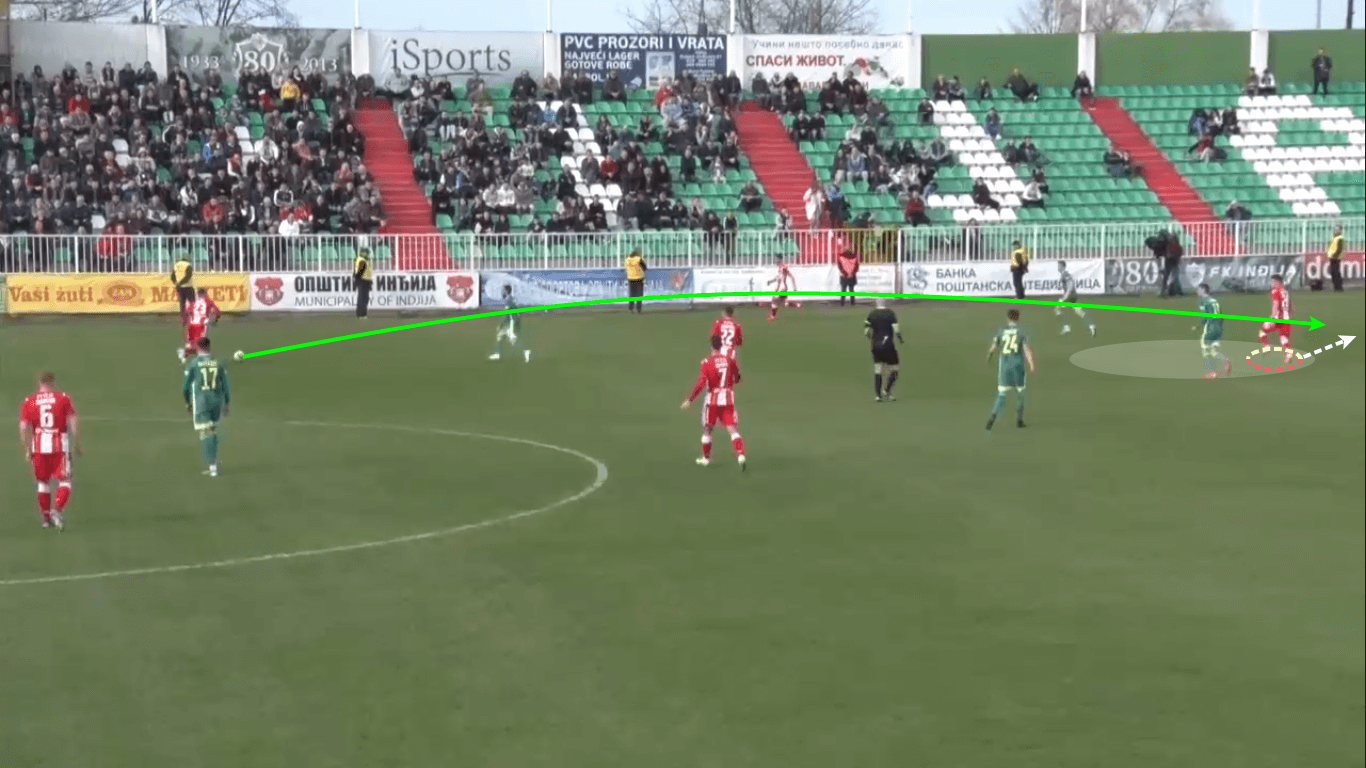
As we can see, Petrović created an advantage over the direct guard in the half-space and
went for a wide run to the flank, from where he’ll commonly provide assistpasses.
The defensive line is not perceivable in this image, but the player is onside and waits for the right moment to run out. We can also see Nikolić dropping lower (no. 22) in order to drag midfielders higher.
Midfield rotations
Red Star’s build-up play also changed with the manpower switch in the midfield. They are now a more possession-oriented team, although that claim is now only based on their matches against weaker opponents in the Serbian Super Liga.
One way or another, the “new wave“ midfield enabled them to play more through the ground and to rely less on their defensive block, but still keeping the good work in the second-ball segment.
Their possession play is based on the midfield rotations, with a clear pattern of midfield line circulation.
The main idea for Serbs is to occupy inner corridors and set their play through the half-spaces, with Petrović and Nikolić playing the positioning of the key parts in those areas after their initial setup goes into the first transformation.
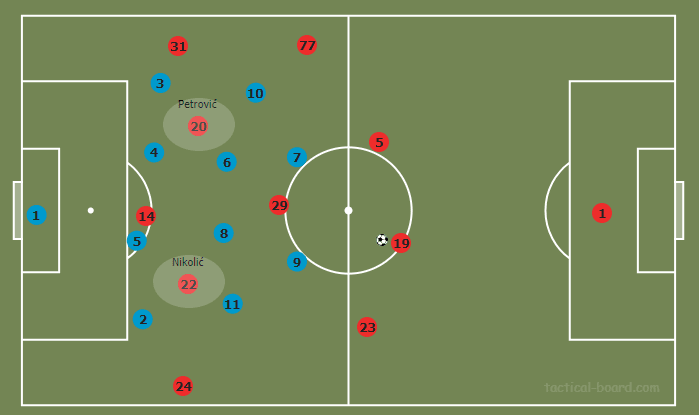
We have mentioned earlier in the analysis how the roles of the two are different in the same areas and here we can see their regular setup against the teams that tend to defend against them in the low block.
Nikolić is often the one that finds his track in those restricted zones, from where he is the main supplier to both Petrović and attackers.
The situation changes when the opposition doesn’t sit that low on the pitch while off the ball, and that leads Red Star into the second tactics transformation, once again directed by the youngster duo.
The rotation that takes place in those settings is seen as the line-switching of their midfield players.
The two defensive midfielders move higher out of the initial setup (shown in the first picture in the analysis), while the attacking midfielder drops lower to become a deep-lying playmaker.
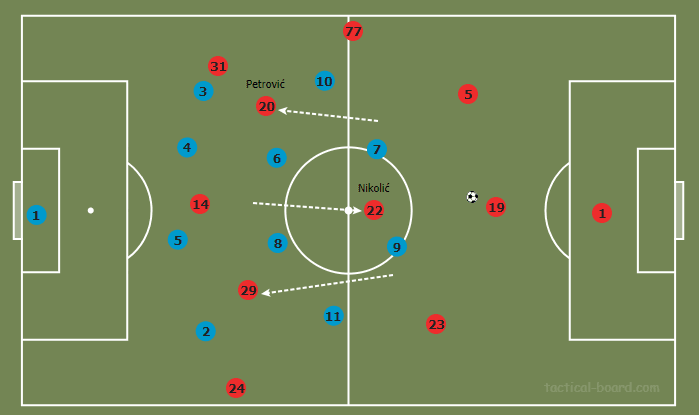
This is the pattern they use most commonly in the build-up phase of the pitch, mostly because Nikolić tends to get involved in all the action around the field.
He’s the guy who likes to be in control and wants to take responsibility, but he also has a good penetrating pass, which makes him valuable in those situations.
On the other hand, this setup allows Petrović to play a little bit higher and wider in cooperation with the winger and to come to his “favourite” zone easier while not as guarded as he is when he’s in the more central position.
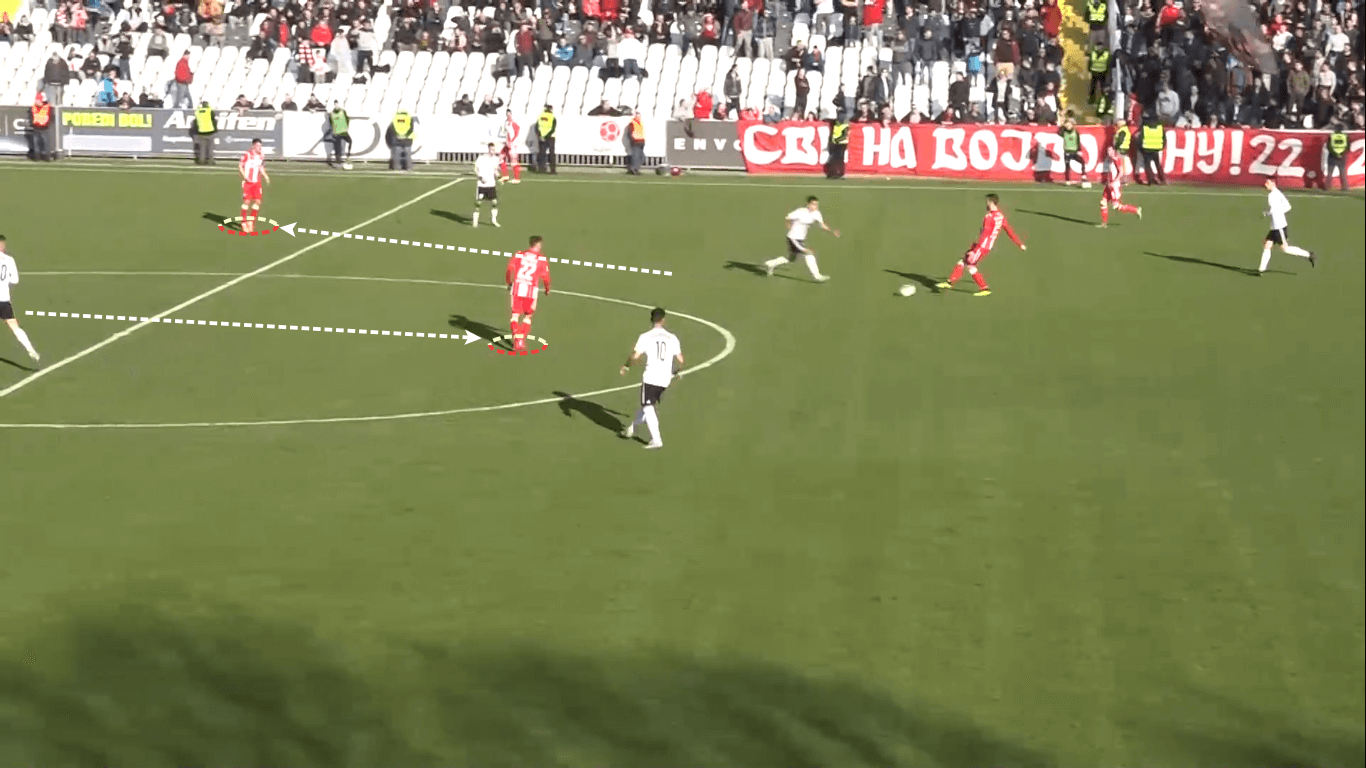
In the picture above, it is clearly shown how Nikolić’s motion triggers Petrović to go deeper and wider.
The attacking midfielder gets the ball in a good position to open up the progressive attack, while the rotational movements of both midfielders confuse the defence and leave both midfielders free to get the ball.
Petrović is then a great forwarding option, both with regular or through-pass, and Red Star’s game thrives due to quite simple manoeuvres.
Midfield cooperation in possession
Two young players, with their diverse skillsets, illuminated the variety of midfield options for the Red and Whites and supplied them with different weapons in the offence.
We have pointed out clearly that Nikolić pulls the creative strings of his team, and Petrović tries to exploit wounds in the opposing team’s structure with his runs and sense for space, finally getting in good goal-threatening positions time and again.
The youngsters communicate pretty well, and they know how to make the best of their possibilities, keeping, relying on their strengths, and covering weaknesses.
So, the number 22 mostly enters the gaps between the midfield and defensive line of the rivals, attracting defenders’ attention to himself, which commonly opens room for his mentioned teammate to run in and get the ball in the dangerous zone.
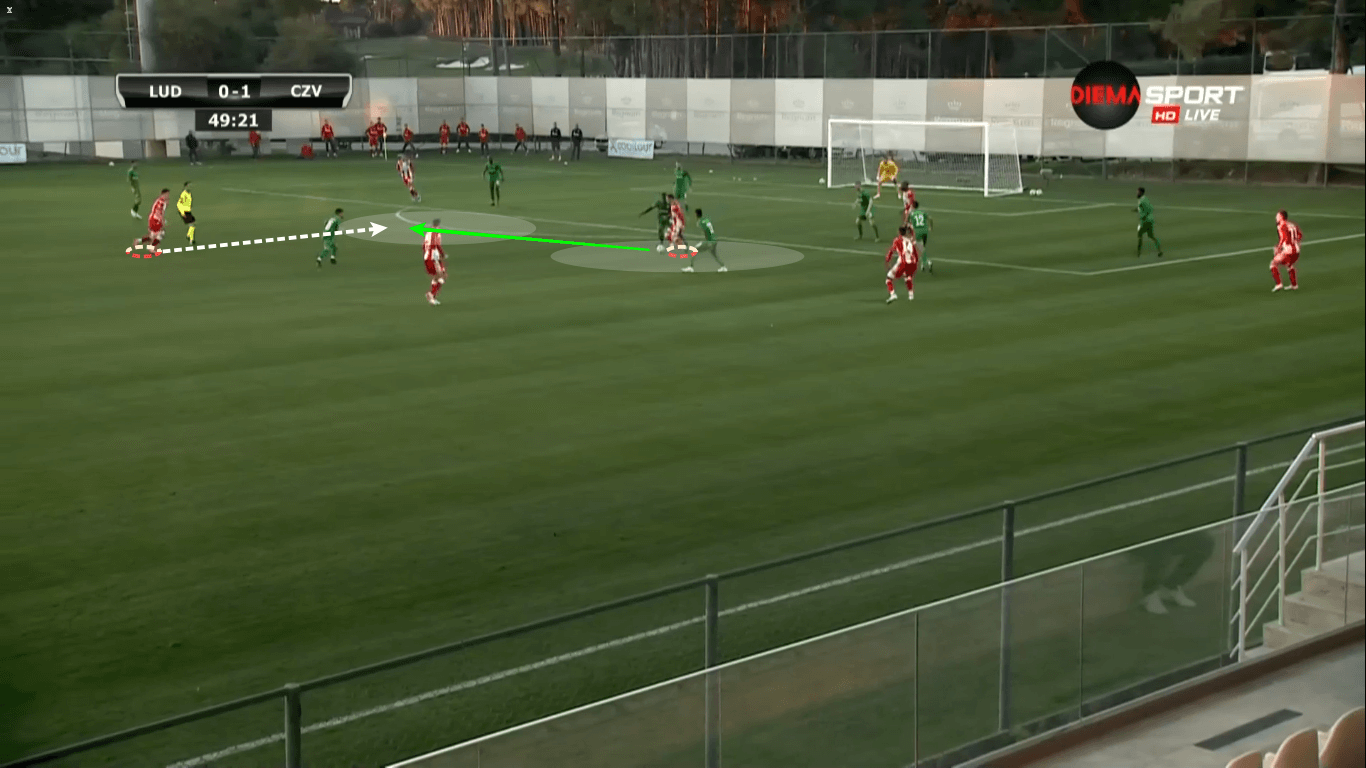
As we can see, Petrović senses the space at the edge of the box and utilizes Nikolić’s well-timed pass after he’s made the surplus situation for his side by dragging players to guard him.
Red Star’s box-to-boxer often takes shots from a distance out of those situations, and because of his powerful shot, those are some of the brightest moments for their side.
Although we said that Petrović’s passing game isn’t his main weapon, he is arguably good in that segment and knows how to break the lines of the opponent’s defensive structure, but he doesn’t do it that often.
If the situation opens up for him to get the ball with no guards around him, he loosens up a bit and gets more creative, with the final intention of going forward and being included in the action-finishing.
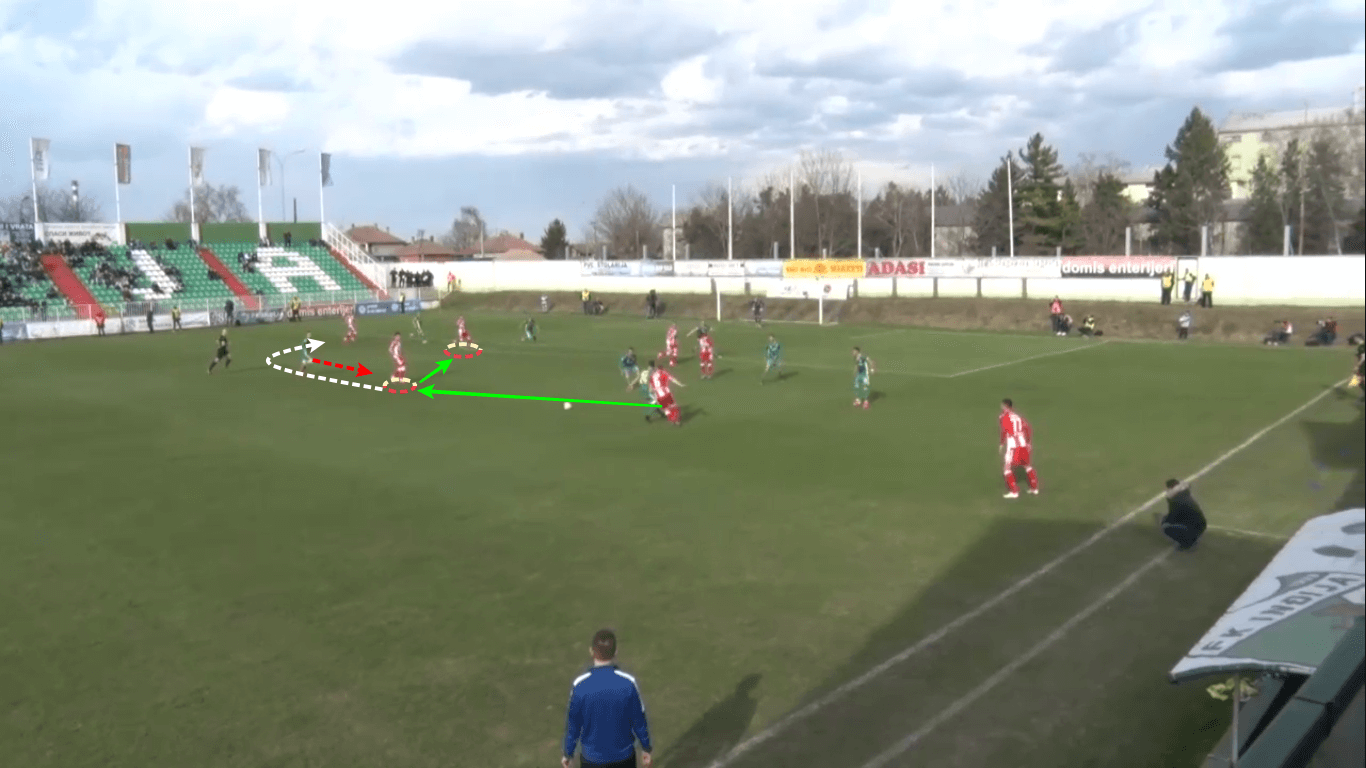
Njegoš positions himself as shown above from time to time and mostly plays a one or two-touch game in those setups.
His main idea is to get the ball to his higher teammates—usually Nikolić —and continue his motion towards the final third, where he expects a return ball or just goes as a help provider.
He goes around the opponent who comes to attack him, like it is pointed out, and pulls up great supportive runs from those settings.
The two cooperate mostly in areas similar to the one in the picture, and they try to break the opponents through the central corridor with direct forward passes.
In those scenarios, Petrović is commonly the one who sends line-breaking passes, and Nikolić positions himself higher and tries to enable forward play with his fast turns due to his good ball control and quick feet or to play a fast pass that will allow their action to continue.
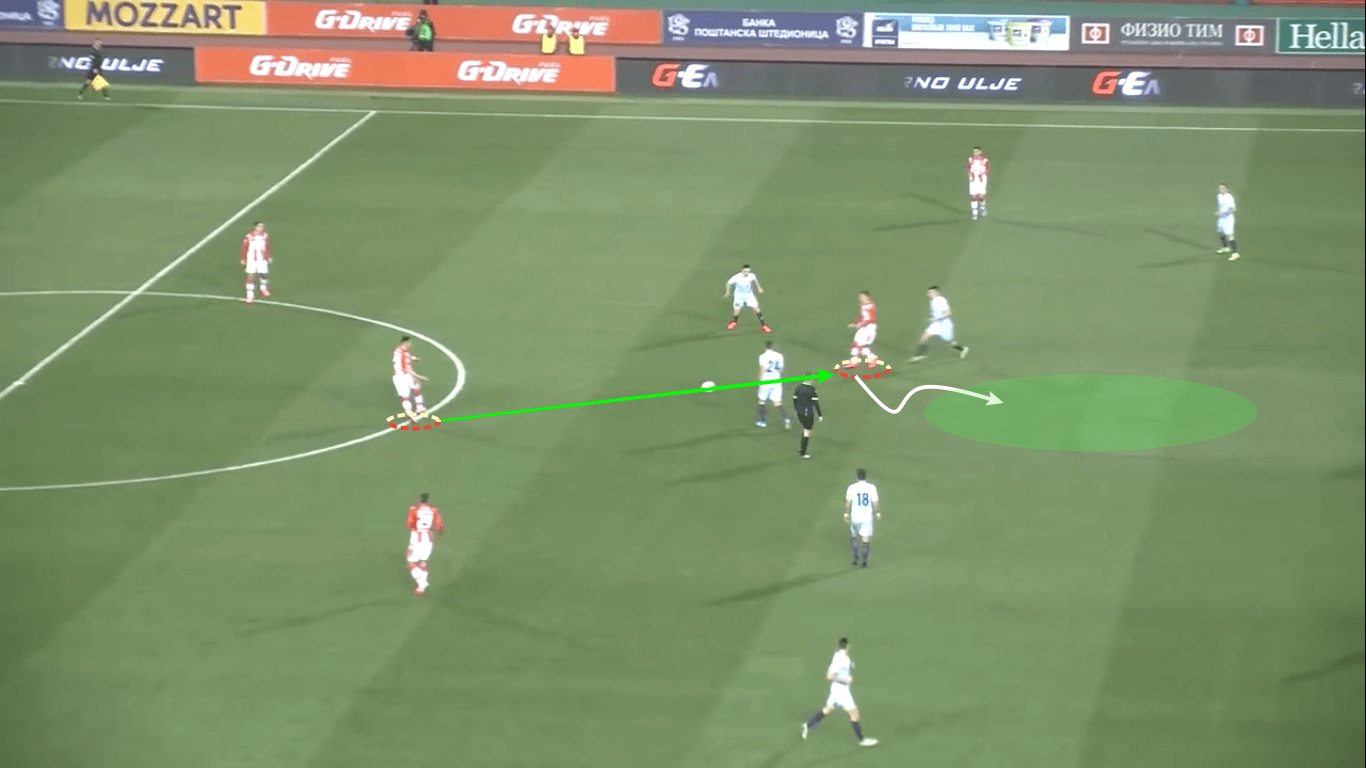
In the image, Njegoš finds Nikolić in a position in which he has a difficult possible 3v1 matchup but trusts his teammate because he knows his skills.
Nikolić does a fast turn which leads him into the open position between the lines and thrives Red Star’s progressive play.
The two of them brought
many surprise factors to Stanković’s tactics, making it possible for the team to sometimes rely on individual players’ skills rather than onlytactical patterns.
Defensive inclusion
After changing the manager, Red Star went through the biggest identity switch when it came to defensive action.
Under Milojević, they felt comfortable defending in the low block and relying on fast transitions as their main weapons, especially in international games.
But today, it seems that they’ve changed their approach and gone to defending in a central block with a tendency to go higher, in a structure in which the midfield duo plays a huge role.
In those setups, Nikolić plays as an “opposition progress director,” channeling the player with the ball into well-organised traps set up by the lower teammates and himself.
He mostly calls the centre-back to enter the higher zone with the ball at his feet by closing him the potential wide option and letting him feel comfortable in the first few steps.
After that, he covers him from behind while Petrović and the other midfielders do the “dirty job” of tackling.
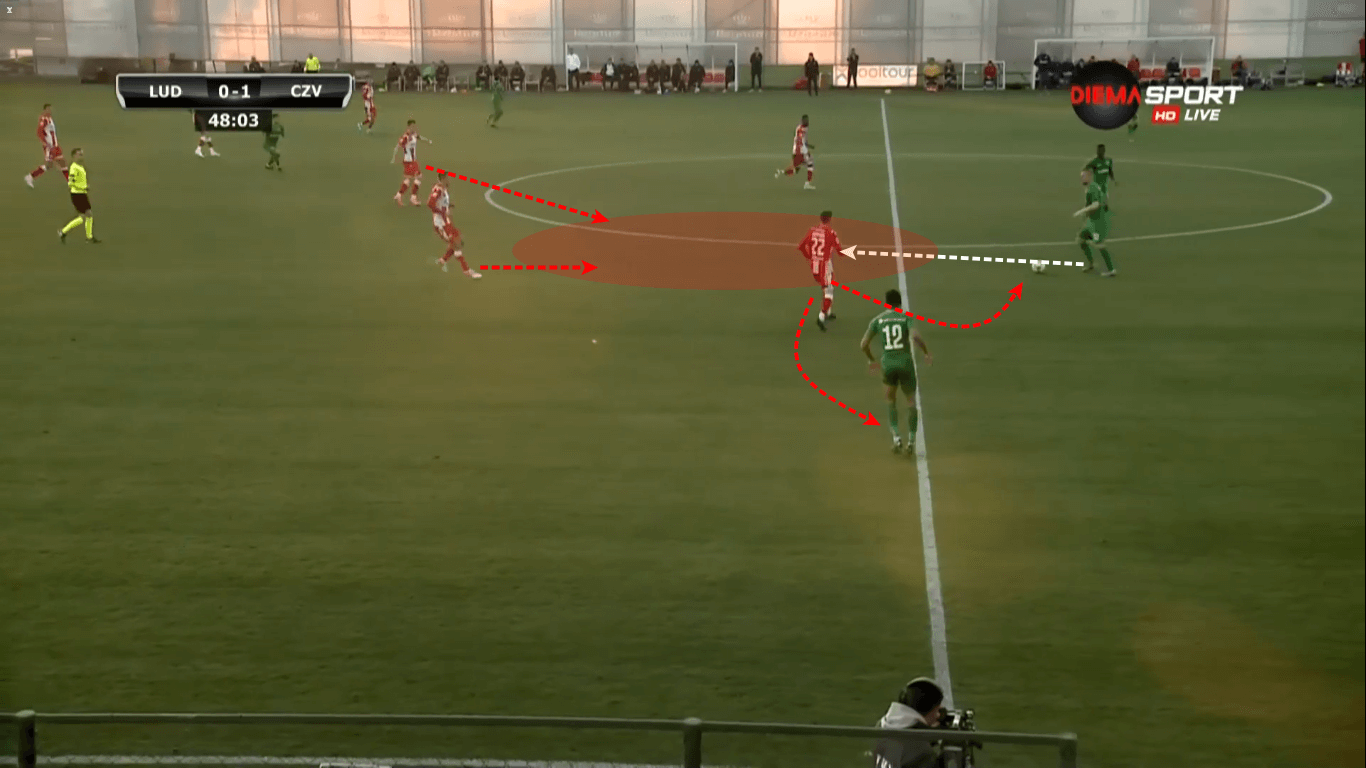
Here, we can see how Nikolić’s motions close down the opposition’s possible flank progress and force defenders to enter the trap zone, where the other two midfielders are waiting, prepared to outnumber technically weaker opponents.
These scenarios habitually happen in the central areas of the pitch because Red Star’s playmaker usually operates in those corridors.
However, he often creates defensive surpluses with his teammates on the flanks by coming closer and doing pretty much the same motions to stop the backward play.
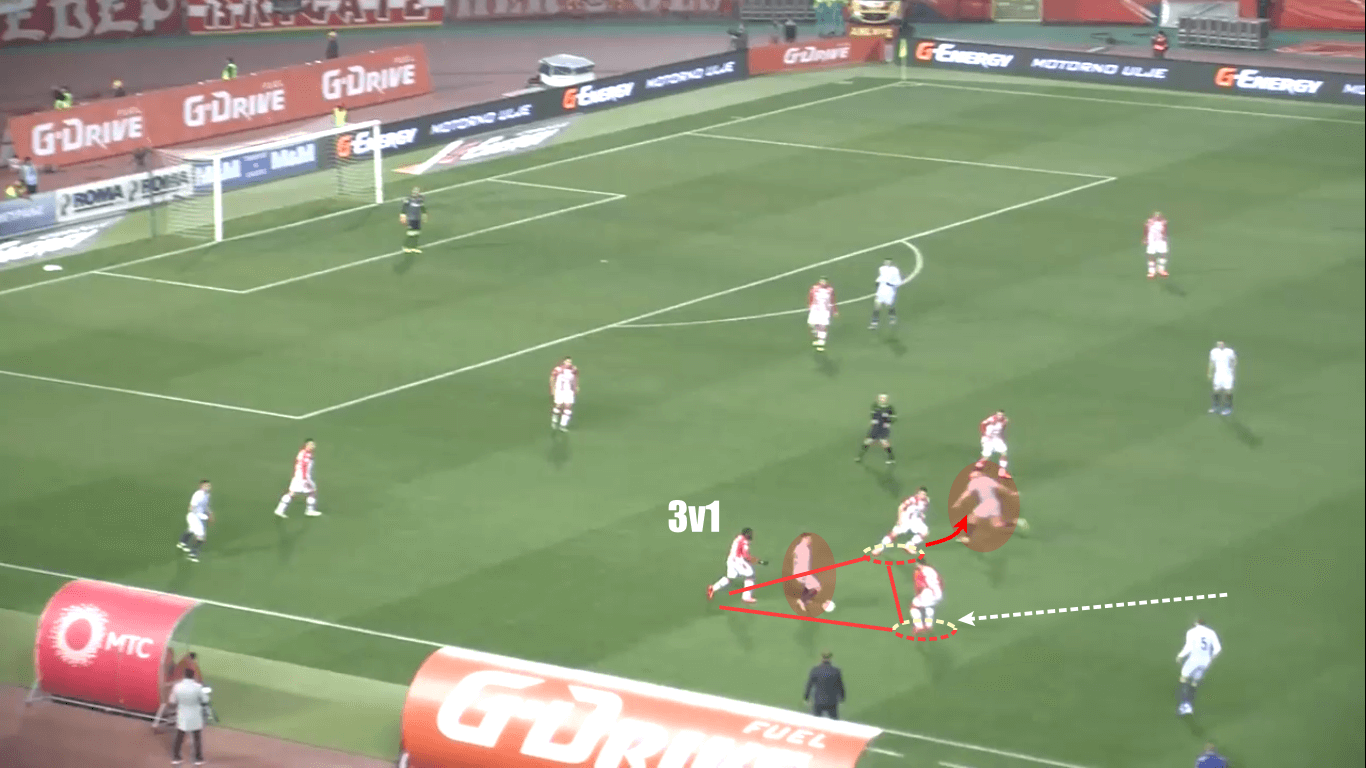
Nikolić from time to time, Nikoli creates 3v1 situations together with the winger and Petrović in the shown areas of the pitch, basically caging the player with the ball and leaving him with no options.
Petrović’s motions are crucial in these positions. He provides the trio with necessary help while still keeping an eye on the player who tries to run behind him.
Also, in the opening stages of opposition attacks, the two of them often guard the opposing team’s “first pass” by closing down the passing lanes towards the defensive midfielders, who will enable forward play.
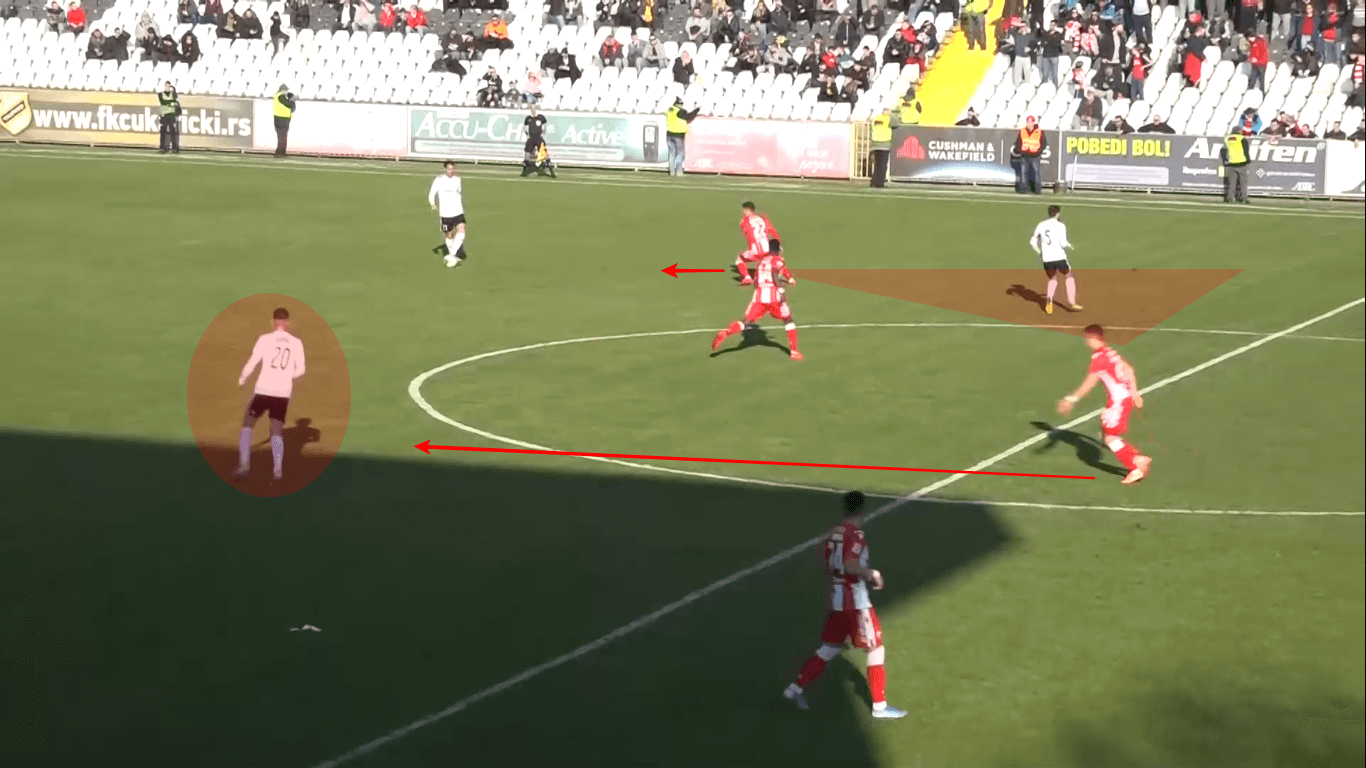
In the image above we see a pattern of their defending in those scenarios.
Nikolić goes with low-level pressure on the player with the ball closing his first progress option with his shadow and forcing him to turn to the central areas for his next pass, whilst Petrović goes aggressively in high-speed pressure towards the other midfielder leaving him no room in the short amount of time after he went for pressing.
Those movements are well-planned and the two youngsters repeat them frequently closing down the potential progress for opponents.
Their inclusion in out-of-possession play is different because Nikolić is more of a “hook thrower” for a player with the ball as he forces him to go into the traps, while Petrović is the muscles due to his physical abilities, well-timed tackles and aggressiveness.
Conclusion
Dejan Stanković brought new ideas to Serbian Marakana and set his tactics in order to profit from the youngsters.
That made a huge room for the inspiring duo of Veljko Nikolić and Njegoš Petrović to show all they had and get the action they had been waiting for.
On such short notice, they’ve shown how good they are and, more importantly, how good they could become, pointing out that Red Star has two possibly very lucrative gems in them.
They fit each other because of their different skillsets and complement each other’s flaws, which makes them interesting to analyse.
With the addition of one responsible defensive midfielder, their biggest strengths would become even clearer, and they would thrive, which could possibly lead Red Star to become one of the most exciting teams to watch in this part of Europe.
If they continue their development in the same way they started it, the two midfielders could easily become the next big transfers out of the academy that created Luka Jović and Marko Grujić.
They could also be the ones to hold Serbia’s national team midfield for the years to come.





Comments